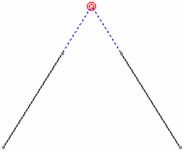Understanding Dimensions between Intersection Points
This sub-topic provides background information to help you understand dimensions between intersection points.
There are two types of intersection points: definite intersection points or fictive intersection points.
A definite intersection point is the meeting point of 2 curves which physically intersect each other.

A fictive intersection point is the meeting point of 2 fictive curve extensions, or a curve and a fictive curve extension.

Creating a dimension between intersection points is a sort of "shortcut" that combines the creation of 2D intersection points, construction lines, coincidence constraints (on 2D elements only), a 2D line and a dimension all at once. There is no actual link between the dimension and the geometry on which it is based.
The table below summarizes the kind of intersection detected in and 2D Layout for 3D Design, depending on the type of element pointed by the pointer.
| The following kind of intersection... | is detected between... |
|---|---|
definite intersection | straight 2D lines |
fictive intersection | a straight 2D line and the extension of a straight line |
fictive intersection | 2 extensions of straight lines |
The table below summarizes the kind of intersection detected in 2D Layout for 3D Design only, depending on the type of element pointed by the mouse.
| The following kinds of intersection... | are detected between... |
|---|---|
definite intersection fictive intersection | 3D curves (edges or wireframe) which are projected as lines in the background of layout views |
definite intersection fictive intersection | a straight 2D line and a 3D curve projected as a line in the background of layout views |